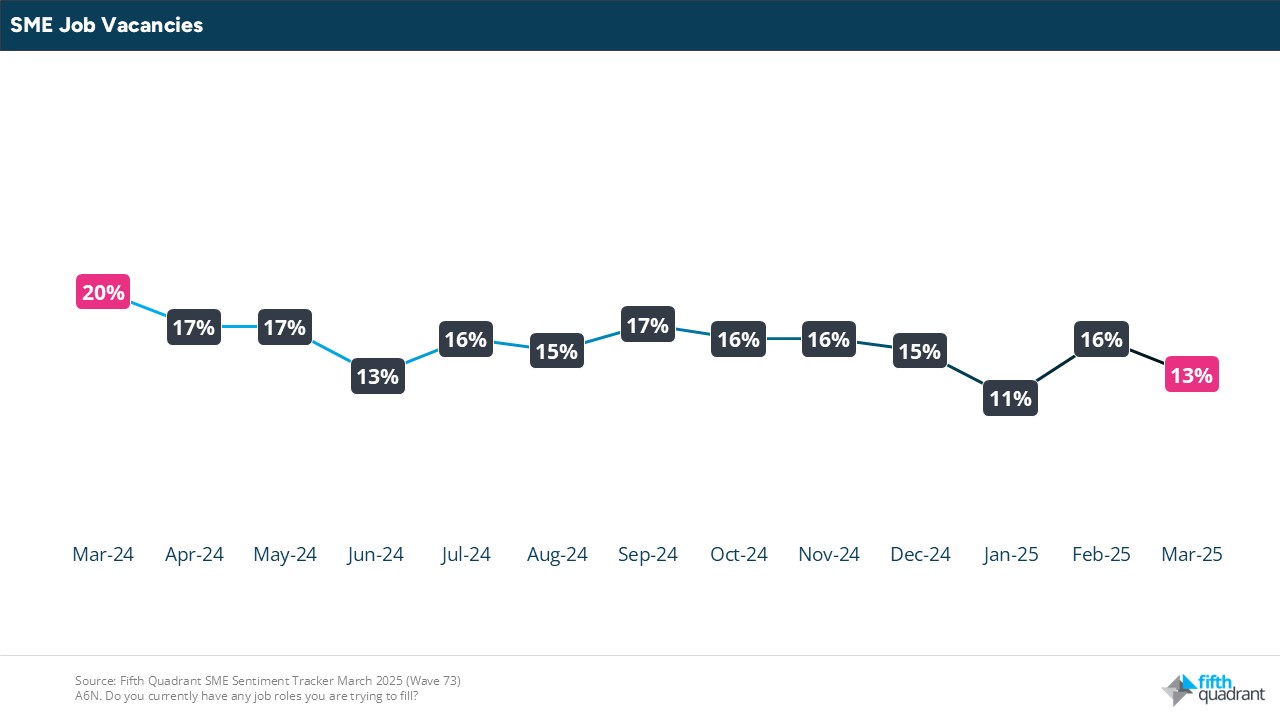Author: Jessica Phan | Posted On: 22 Apr 2025
Australia’s workforce is shifting, and many small and medium-sized businesses (SMEs) are struggling to keep pace. Emerging recruitment trends show that workers are entering the market with different expectations around flexibility, wages, and work–life balance, while businesses are facing rising costs, skills shortages, and broader uncertainty.
This results in a growing disconnect between what employees want, and what businesses can realistically offer. Unfortunately, this friction is not something SMEs can afford to ignore; adapting hiring strategies and workforce planning can be difficult, but it’s becoming more critical for long-term viability.
SMEs are navigating challenging economic times too
Our previous blog post focused on the challenges facing workers, but current conditions are also hitting smaller businesses hard. According to the March wave of Fifth Quadrant’s SME Sentiment Tracker, 46% of SMEs say their top challenge is navigating a difficult economic outlook, in addition to mounting cost pressures. Nearly half (46%) are focused solely on maintaining revenue, while one-in-five (20%) expect to downsize or exit the market within 12 months.
Given this, it is unsurprising that hiring activity has slowed, with job vacancies falling from 20% to 13% over the past 12 months. These numbers show businesses are approaching recruitment with a more cautious mindset, and in many cases holding back on hiring decisions.

4 recruitment trends showing growing mismatch between employees and employers
In addition to the economic pressure, many employers are finding that a growing disconnect with applicants around their capabilities, needs and wants is also adding to the strain. Looking at this in more detail, we have identified four critical areas of concern for Australian SMEs.
- Applicants not living up to employers’ skills expectations
Over half (53%) of SMEs report that a lack of skilled or qualified applicants is their primary hiring obstacle. Moreover, an Australian HR Institute study found that 57% of employers are experiencing productivity impacts due to skills gaps, which is more pronounced amongst under-resourced SMEs. - Employers don’t have the budget for the salaries that applicants are demanding
Similarly, 49% of SMEs report that applicants are asking for more than they can afford. While they recognise that applicants are feeling cost-of-living pressures and need a salary to supplement this, recent minimum wage increases, and climbing inflation are adding further pressure. - Applicants want flexibility, but businesses need consistency
As we see many larger businesses pushing for a return to full-time in-office roles, 70% of SMEs are choosing to offer flexibility around work hours and remote options. But flexibility has its limits, with one-in-four SMEs saying applicants aren’t willing to work the hours they require. As a changing workforce seeks out non- traditional working arrangements, SMEs must rethink how jobs are structured to find common ground. - Technology is advancing, and some workers are struggling to keep up.
This is helping them streamline operations and reduce costs but also accelerating workforce change. Prospective workers need to demonstrate that they understand how to leverage these technologies to deliver stronger outcomes for their employers without losing the human touch.
change is inevitable, and SMEs need to catch up
Many SMEs are responding to the economic situation by holding off on what they deem unnecessary for short-term survival, such as hiring, marketing activities and growth strategies. However, prolonged inaction carries the risk of falling behind, and without adapting, businesses may find themselves under-resourced and unprepared when conditions improve.
However, adaptation does not require a complete transformation; targeted strategies can support long-term resilience and competitiveness, such as redesigning roles, job sharing or hybrid arrangements, and upskilling staff. While it is easy to get caught up in the hype of technological advancements, businesses can’t afford to lose employees who bring human connection and add value to customer experience and problem-solving.

Stay up to date with the latest insights from our SME Sentiment Tracker, published monthly by Fifth Quadrant and Ovation Research.
To stay competitive in a rapidly changing labour market, SMEs need more than instinct – they need insight. At Fifth Quadrant, we specialise in B2B market research that helps businesses understand emerging recruitment trends, workforce expectations, and operational challenges. If you’re planning ahead or navigating change, partner with us to uncover the insights that drive smarter decisions. Get in touch to learn how we can support your next move.
Posted in Social & Government

